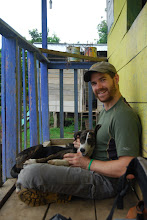Bright white egrets stalked around wooden debris jutting into the river, plucking unwary minnows from the current, while most of the large Cucoi herons perched stoicly upon the tree trunks speckled around us in the river. Their wings slumped away from their sides, and their beaks hung agape as their throats undulated, panting air like a dog.
Once in awhile some of them would become a little too uncomfortable as we passed in the vibrating peki-peki, and with a lazy, fluid motion they would crouch and turn away from us, them jump into the air like a puppet, as if they had just been lifted by invisible strings. A few feet into the air they opened their wings, casting a wide shadow across the water a foot or two below them. With slow, labored wingbeats they float away through the air, craning their neck momentarily to be sure they are not being pursued. Through my binoculars I follow their wingtips as they pass barely an inch above the water with each stroke. I smile, catching a few swirls in the water where their wings come closest to the surface. They are such a large bird, yet they master such delicate and graceful flight.
Up ahead I see an odd, black, lanky form sticking up from the water’s edge. What at first appears to be an animal, then an odd tree stump, turns out to be a spider monkey wading in the water up to its chest. I point it out to every one else just as it spots us coming up river. It turns to run back across shore, stopping momentarily on the long river bank to stare us down, then turns and continues running the fifty meters of so across the large gravel bank until it disappears into the safety grass close to the trees. It appeared as though it was about to swim across the fiver, but perhaps it was just seeking to cool off and have a drink on this very hot day.
Waves of heat rippled over the sandbar like mirages in the desert. Above us, a cloud of kites, vultures, falcons, and storks swirled around in the thermal, quickly rising into the sky. With the river being so low recently, these exposed riverbanks create perfect islands of heat, which these birds take advantage of to navigate long distances, sometimes only flapping several times an hour.
As we leave the sand bar behind us, I look ahead upriver to see the storks cruising out ahead of us now. Wings slightly curved, I could see the feathers close to their body rippling in the wind as they accelerated past us. Just as they were getting low enough for me to see the black and white of their wings again, they broke out of the descent, banking back into the lazy swirl of another thermal rising above the next sandbar perhaps a half mile upstream. In the two or three minutes it took for us to get directly beneath them again, they had become specks in the sky once more. Looking over my shoulder, they dropped out of the thermal and descended rapidly towards the horizon, disappearing over the jungle canopy to the next unseen thermal lying just upstream around the river bend.
Amidst one of these clouds of climbing birds, I watched several falcons and kites stoop down out of the sky upon some unseen prey below. Dropping several hundred feet in only a few seconds, I can rarely help but gasp or yell to draw the spectacle to other’s attention. I watched one Plumbeous kite drop towards the sandbar, grappling with some smaller creature the size of a huge dragonfly or a hummingbird for a few seconds before pulling out of the stoop to avoid hitting the ground. I watched the prey streak away in the other direction inches off the ground, still unsure as to whether it was a hummingbird or a dragonfly. Down here, they are of very similar sizes.
While the air may feel fresh as the peki-peki labours upstream, once we land back at CICRA, the air sits heavily upon us again. By the time we have arrived at the top of the staircase some 240 steps later, sweat drips from my face, but at least it is lunch time, which means some cool, sweet refresco awaits my parched lips.







